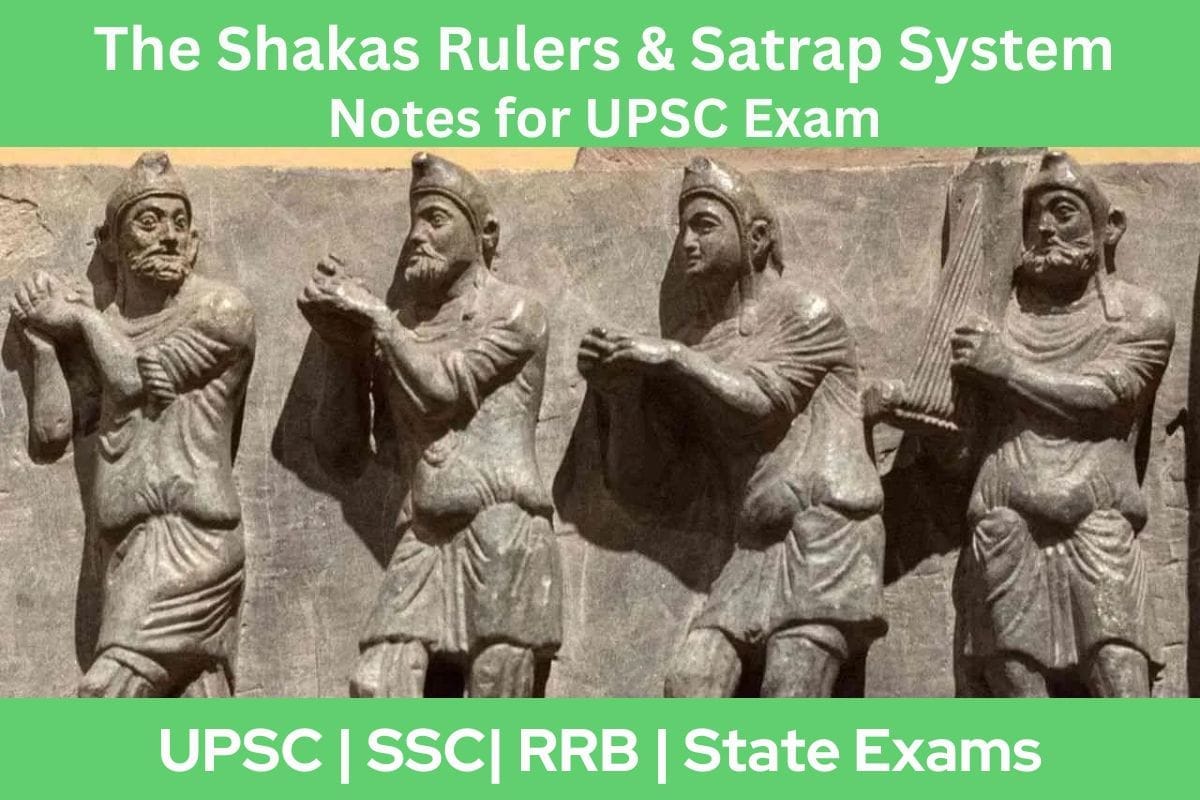
The Rise Of Shakas
- In the 2nd century B.C., a group of nomadic people from Central Asia, known as ‘Yueh-chi’ or ‘Yuezhi,’ displaced the Shakas from their homeland, pushing them to invade India from the northwestern border of present-day China.
- The descendants of these invaders later became known as the Kushana.
- The Shakas, in turn, invaded Parthia and Bactria, defeating the Parthian King and gaining confidence to move further into India. Maeus was the first to establish Indo-Scythian rule in India.
The Shakas split into five distinctive branches, each settling in different parts of North and North-Western India:
- Afghanistan
- Punjab with Taxila as the capital
- Mathura
- Western India
- Upper Deccan with Ujian as their capital.
Among these branches, the Central and Western Indian branches gained prominence, ruling India for a longer period compared to other Shaka rulers.
Important Rulers
In the Saka era, there were some notable rulers:
Maues (King Moga):
- Maues, also known as King Moga, was the earliest Shaka or Indo-Scythian ruler in India.
- He established Shaka rule over the Gandhara region, which is present-day Afghanistan and Pakistan.
- His capital was Sirkap in present-day Punjab, Pakistan.
- Maues led unsuccessful invasions against the Indo-Greeks, issuing numerous copper coins and fewer silver coins with Greek and Kharosthi scripts.
- His coins featured images and symbols of Indian deities from Buddhist and Hindu religions.
- The Taxila copper plate, with inscriptions in Kharosthi script, belongs to Shaka King Moga.
Azes I:
- Azes I, Maues’ son, ended Indo-Greek rule in India, defeating the Graeco-Indian king Hippostratos.
- He initiated the Azes era in 58 BC, coinciding with the famous Vikrama Era in India.
- Azilises and Azes II:
- Azilises succeeded Azes I, and Azes II followed him.
- Some coins were jointly issued by Azilises and Azes II.
- Azes II, the last significant ruler of the Shaka dynasty in this era, succumbed to the Kushan Empire.
Nahapana:
- Nahapana revived the Shaka Empire’s prominence and established the Kshaharatas dynasty in North and North-Western India.
- He faced defeat at the hands of King Gautamiputra Satakarni of the Satavahana dynasty.
Chashtana:
- Chashtana succeeded Nahapana and ruled the Western Kshatrapas or Satraps with Ujjain as his capital.
- Ptolemy referred to him as ‘Testenes’ or ‘Tiasthenes.’
- Chashtana initiated the Bhadramukhas dynasty.
Rudradaman I:
- Rudradaman I, the grandson of Shaka king Nahapana, stood out as the greatest ruler.
- He made Ujjain a significant cultural and educational center.
- Assuming the title ‘Makakshatrapa,’ he contributed to Sanskrit arts and literature, issuing the first long inscription in Sanskrit.
- Rudradaman I repaired the Sudarshana lake in Kathiawar and reclaimed lost territories through conquest.
- He converted to Hinduism and maintained a marital relationship with the Satavahanas.
- Yavanasvera, a Greek writer, translated ‘Yavanajataka’ from Greek to Sanskrit during his rule.
- These rulers played crucial roles in shaping the history of the Saka era.
Decline Of Shaka Era
- The Shaka empire in the Gandhara region (northwestern Pakistan) started falling apart during Azes-II’s rule after a defeat from the Kushan Empire.
- Another big hit came from Gautamiputra Satakarni, the ruler of the Satavahana Empire, weakening Shaka dominance in the Indian subcontinent.
- Eventually, Chandragupta-II of the Gupta Empire dealt the final blow, defeating the last Shaka ruler, Rudrasimha III, and reducing the Shakas to a small regional kingdom.
Satrap System
- The ancient Sakas in India set up a Satrap system of government, similar to what the Parthians did.
- This system, much like the one used by the Iranian Achaemenid and Seleucid, divided the kingdom into provinces.
- Each province had a military governor called a Mahakshatrapa (great satrap), and the lower-ranking governors were known as kshatrapas (satraps).
- These governors had the authority to put out their own writings and create their own coins.
- In today’s terms, the term ‘Satrap’ is sometimes used metaphorically to describe world leaders or governors who are strongly influenced by larger world powers and act as their representatives.
Satrap Groups
The Ancient Sakas, who ruled with the assistance of military governors and satraps, referred to themselves as ‘King of Kings.’ These leaders oversaw different regions and held significant responsibilities.
Satrap of Kapisa:
- According to the Moga inscription, Liaka Kusulaka and his son Patika Kusulaka were satraps of Kapisa.
- Patika Kusulakaru ruled with the title ‘Mahadandapati.’
Satrap of Mathura:
- Hagana and Hagamasa were the initial satraps of Mathura, succeeded by Sodasa, Sivdatta, and Sivaghosha.
- Mathura Satraps’ coins featured a standing image resembling Laxmi and three elephants.
Satrap of Western India
- Bhumaka ruled over Saurashtra, with Nahapana as a significant ruler.
- The satrap’s coins bore the lion capital symbol, mentioning Bhumaka as a Kshakarata Kshatrapa.
Satrap of Ujjain:
- Castana or Shastana founded this satrap, using Greek, Kharoshthi, and Brahmi scripts on their coins.
- Rudramadaman I, a mighty ruler, identified as a Mahasatrap, conquered various regions and defeated Saatkarni of the Satvahan dynasty.
- He portrayed himself as a protector chosen by all castes, claiming victories in Malwa, Saurashtra, Gujarat, Konkan, and Yudehas of Rajputana.
Yavanesvara, a Greek writer, translated the Yavanajataka from Greek to Sanskrit, influencing Indian astrology.







